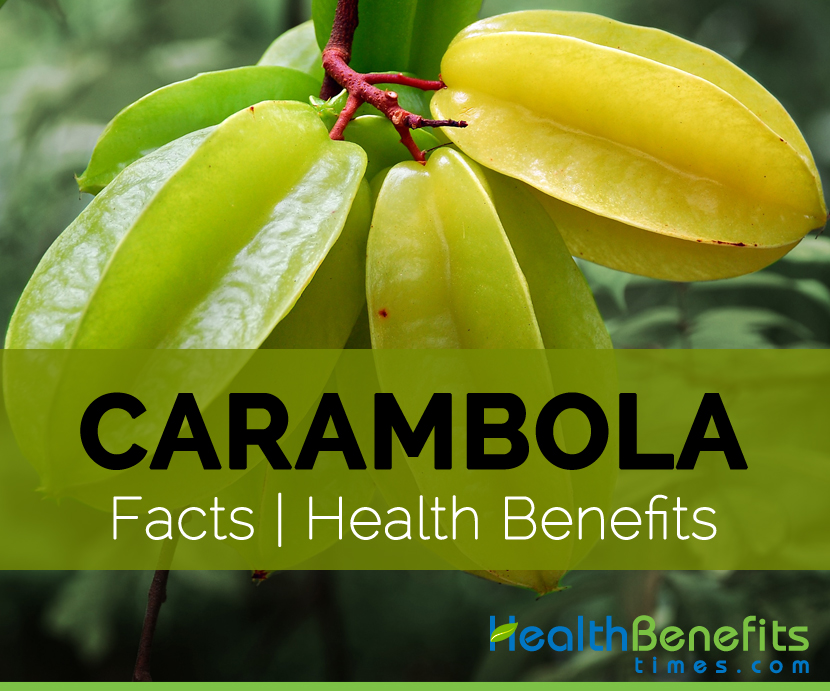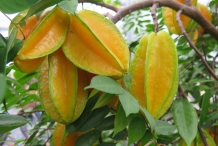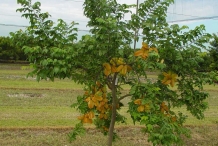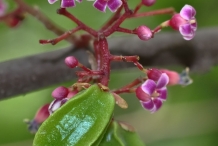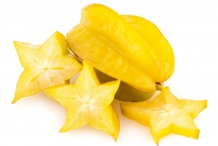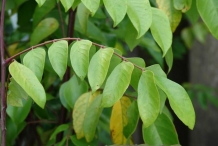| Carambola Quick Facts |
| Name: |
Carambola |
| Scientific Name: |
Averrhoa Carambola |
| Origin |
Malayan peninsula, also cultivated in Southeast Asia, Pacific islands and China |
| Colors |
Light to dark yellow, smooth with a waxy cuticle |
| Shapes |
Ovate to ellipsoid, star shaped, length: 2-1/2 to 5 inches (6 to 13 cm) |
| Flesh colors |
Translucent and light yellow to yellow |
| Taste |
Tart and sour to slightly sweet |
| Calories |
138 Kcal. Kcal./cup |
| Major nutrients |
Vitamin C 41.33%
Copper 16.44%
Vitamin B5 8.44%
Dietary Fiber 7.89%
Carbohydrate 5.59% |
| Health benefits |
Antioxidant activity, Analgesic, Hypoglycemic, Anthelmintic and Antiulcer activity |
| More facts about Carambola |
Carambola, which is scientifically known as Averrhoa carambola, is a fruit bearing tree of the family Oxalidaceae and genus Averrhoa. The tree as well as the fruit is popular by different names in different languages such as Haitian (Zibline), Tonga (Tapanima), Khmer (Spu), Laotian (Nak Fuang), Polish (Karambola) and others. Carambola is widely popular throughout the world and is known as Carambola, Coolie Tamarind (Trinidad), Coromandel Gooseberry, Country Gooseberry, Five Corner (Australian), Five Fingers (Guyana), Starfruit and Star Pickle.
History
Carambola is native to Malayan Peninsula but nowadays it is also cultivated in many parts of the Southeast Asia, Pacific Islands and China for its fruits. Carambola was originated in West Malesia and for centuries it was cultivated in Southeast Asia and Malaysia. It has been naturalized in northern South America.
Plant
The carambola tree is slow-growing, deciduous, perennial tree, short-trunked with a much-branched, bushy, broad and rounded crown. The tree reaches upto the height of 6–9 m. The flowers are pink in color, bell shaped with 3/8 inch in diameter. Leaves are arranged spirally and alternate in 15-20 cm length. The leaflets are ovate or oblong with length: 2–8.5 cm and broad: 3–4.5 cm. It grows in tropical and sub-tropical climates which is wet, humid. The plant flowers throughout the year. The plant has the lifespan of 40 years.
Fruit
The fruit is smooth and dark yellow in color with a waxy cuticle. The fruit is ovate to ellipsoid and star shaped in 2-1/2 to 5 inches (6 to 13 cm) in length. The skin’s peel is thin. The taste of the fruit is pleasantly tart and sour to slightly sweet. It has the combined flavor of pineapples, plums and lemons. Its flesh is translucent from light yellow to yellow in color. It has 10 to 12 seeds. The seed is ovoid in blackish brown color about 0.25 to 0.5 inches (0.64 to 1.27 cm) in width.
Nutritional Value
Averrhoa carambola is fully packed with vital nutrients. It is a very good source of natural antioxidants like L-ascorbic acid, (-) epicatechin and gallic acid in gallotannin forms. Consuming 108 g of this fruit can provide, 33 Kcal calories, 1.12 g proteins, 7.27 g carbohydrates, 3 g dietary fibre, 0.36 g fat, 3 mg calcium, 0.09 mg iron, 13 mg phosphorus, 144 mg potassium. Moreover, various amino acids like 0.009 g of tryptophan, 0.023 g of methionine and 0.083 gm of lysine are also present in 108 g of the fruit.
Health Benefits of Carambola
- Antioxidant activity
The strong correlation was shown between the antioxidant activity and total phenolics and proanthocyanidins contents. Fewer amounts of flavonoids are found in the fruit whereas the correlation between antioxidant activity and ascorbate content was found poor. Carambola possesses huge phenolic antioxidants that provide health benefits. The huge presence of phenolics and antioxidant activity provides various benefits to the health when it is used in functional food products.
- Anti-microbial and antifungal activity
The extract of ethanol, butanol fractions, ethyl acetate, hexane and flavonoids such as fucopyranoside from the leaves of carambola is used for the purpose of anti-inflammatory. The extract of ethanol lowered edema when it is taken in dose dependent manner. The ethanol extract also prevented the Myeloperoxidase activity.
3. Antitumor activity
The study conducted on the cultured cells of Carambola concluded that it has possessed the ability to hydroxylate sesquiterpene compounds in a region and steroselective manner. The research was made on the brain tumor cells with the alcoholic extract from the carambola stems but the leaves extract was efficient against the liver carcinoma cells.
- Antiulcer activity
The water alcohol extract of the leaves of Carambola was examined about the potential of anti-ulcerogenic. When the research was conducted on rats, it does not showed the indomethacin and acute stress ulcerogenic models which shows that the presence of ethanolic extract of Carambola possess lower anti-ulcer activity.
- Hypotensive activity
The hypotensive effect was studied on the isolated rat aorta with the aqueous extract. It reduces the induced contractions and contractile mechanisms. The conclusion derived from the aqueous extract shows its hypotensive nature.
- Hypocholesterolemic activity
The potential of hypocholesterolemic activity was examined of different insoluble fibers which is prepared from Carambola. The insoluble fibers of Carambola lowered the serum triglyceride and total cholesterol by promoting the elimination of cholesterol and bile.
- Nephrotoxic effect
The study about the effects of Carambola on the patients of renal failure shows that the fruit and its juice may urge neurotoxicity and nephrotoxicity. The patients of chronic disease should avoid carambola. Those having normal renal function should also avoid the consumption of fruit or juice on an empty stomach.
- Analgesic
The study which was conducted on the analgesic activity of the Carambola fruit shows that it shows the significant central and peripheral analgesic activities in acetic acid.
- Hypoglycemic
The pulp of ripe Carambola possesses the hypoglycemic effect which reduces the levels of blood glucose. The report shows that the dietary fibers, alcohol insoluble solid and water insoluble solid segregated from the pomace of Carambola acquire the hypoglycaemic effects.
- Anthelmintic
Carambola leaves showed an anthelmintic activity in dose dependent manner which shows the time of paralysis in 10 minutes and the death in 16 minutes in 100 mg/ml concentration.
- Hypocholesterolaemic & Hypolipidemic activity
The report on an isolated water-insoluble fiber rich fraction (WIFF) in the star fruit pomace shows the hypolipidamemic and hypocholesterolaemic activity. It reduces the cholesterol and lipid by promoting the extraction of cholesterol and bile acids. It reduces the triglycerol in serum, liver cholesterol and raises the cholesterol, total lipids and bile acids.
https://www.youtube.com/watch?v=-hxtLxQqqSk
How to eat
It could be eaten in the form of the juice, smoothie, shake or raw. Due to the presence of slightly tartness, it could be made a pickle as well. It could be mixed with tropical fruit salad, fresh lime juice, little honey and zest. It could be floated in a fresh summer punch or either sauté with shrimp, chicken or meat.
Precautions
As it possesses oxalic acid, it should be avoided by the patients of kidney failure and kidney disease. One should consult a pharmacist before the consumption of starfruit because this could interfere or interact with the prescription medications. The symptoms for the intoxication of starfruit may include nausea, persistent hiccups, agitation, vomiting, insomnia, convulsions and mental confusion.
References:
http://www.rroij.com/open-access/averrhoa-carambola-an-updated-review.pdf
Comments
comments


